Vet Med Students Experience Veterinary Research During Summer Research Training Program

Vet Med student, Mary Kate Feldner, discussing her poster.
August 23, 2018
Nineteen Vet Med students participated in the College of Veterinary Medicine’s Summer Research Training Program (SRTP) this past summer. They not only conducted research, but made a poster and got a chance to present it, including at SRTP's July 31st end-of-the-summer poster session.
According to the director, Lois Hoyer, SRTP is intended to be a pipeline into veterinary research. Its goal is “to identify the students who have a potential interest in a research-focused career or a career that has some research component to it, and then start them out early.” Because many SRTP students are just finishing their first year of the veterinary program, they can find another research opportunity next summer to continue to build their research credentials.
In fact, some SRTP students continue working with their mentor to further explore the area they researched this summer.
“It happens very frequently,” says Hoyer, “so that's just fantastic for me, the student, and for the mentor.”
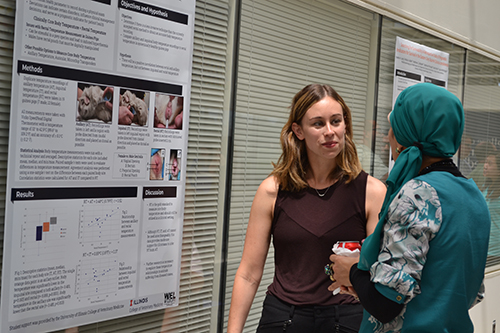
Vet Med student, Ivanna Levy, explains her poster.
She adds that Illinois’ SRTP is part of a national program found at every veterinary school in North America, and is even expanding into Europe. Part of a whole culture of veterinary medicine programs nationally, Illinois’ SRTP hosted the July 31st poster session in order to allow the students to practice presenting their poster before going to the National Veterinary Scholars Symposium hosted by Texas A&M this year.
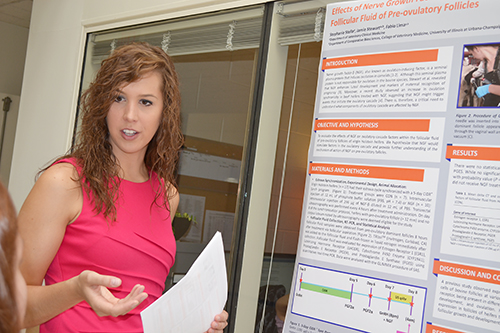
Vet Med student, Stephanie Stella presents her research to a visitor to the SRTP poster sesion.
Funding for Illinois’ SRTP program comes from several sources. Hoyer is PI of an NIH (National Institutes of Health) T-35 grant. She also has a grant from Boehringer Ingelheim, an Animal Health Company, which she says has a 25-year history of promoting veterinary practitioners and scientists in the country. “That's in their own interests,” Hoyer says. “They also think that this is really an important thing to have people who have clinical skills and people who also have some research skills.” Plus, the College funds about three students in the program every year. Some funding even comes from the researchers/mentors themselves, who see the value of having a veterinary student join their research lab for the summer.
Jessica Kerr
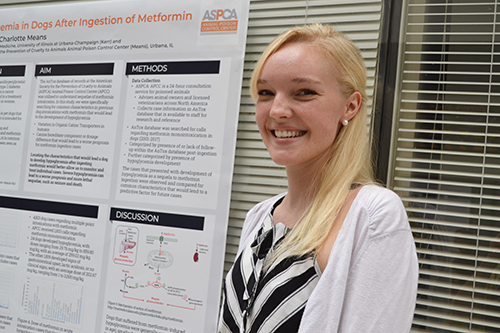
Vet Med student, Jessica Kerr, with her poster at Vet Med's end-of-summer poster session.
One 2018 SRTP participant was third year vet med student Jessica Kerr, whose research was a study about dogs that accidentally ingest the drug Metformin. The top treatment for Type 2 Diabetes, Metformin is everywhere, Kerr reports, so this happens a lot. Humans accidentally drop it, or leave out on tables, or the dog gets into their owner’s purse and tears the bag.
Kerr’s research found that whether or not a dog developed hypoglycemia wasn’t based on the dosage they imbibed, but was possibly a genetic issue or dependent upon their breed. Unlucky breeds were Maltese, Doxens, Shih Tzus, and Schnauzers, adding that “Miniature Schnauzers and Chihuahuas were actually our big kiddos for the development of hypoglycemia.”
Since the two breeds most susceptible were so small, did size impact the results? Kerr says no; they took body weight into account, actually measuring the mg/kg of the dog. “So whether it was a big dog that ate a lot of pills or a small dog that took a few pills, it's the exact same average dose in the end,” she explains.
Kerr was quick to report that the dogs in the study were not test subjects. “No, no test subjects. Never. Not for me!" she asserts. She explains that their study’s data were obtained from people who called into the ASPCA’s animal poison control center, lamenting, ‘Oh no, my dog ate this pill! What do I do?’”
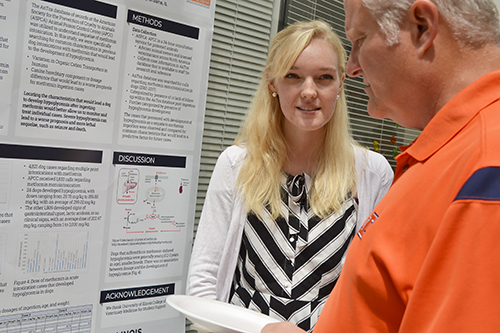
Jessica Kerr discusses her research with a visitor to SRTP's end-of-summer poster session.
Kerr shares that SRTP this summer was a precursor to doing research in her own clinic some day. “So I want to be a general practitioner and work with all sorts of animals,” she says.
This wasn’t Kerr’s first research experience. As an undergrad at Milliken University, she reports having “an amazing time” with their summer research program. The doctor she worked for did a lot of pain studies and incorporated research into his clinic. “And that's what I want,” she admits.
So while she had already made her career decision, she says her experience this summer pretty much confirmed it. “It just reaffirmed that I can do it. I did a big study with about 5,000 dogs in the course of 10 weeks, so it just kinda’ showed me that I can do it.”
Danielle Schneider
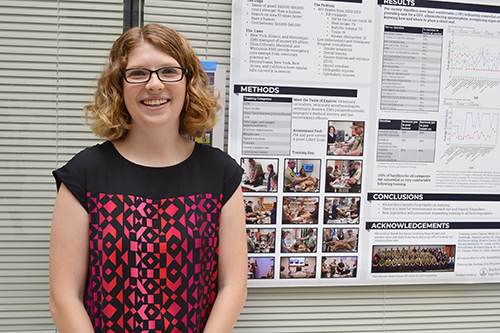
Third year Vet Med student, Danielle Schneider, with her poster.
For third year veterinary student Danielle Schneider, SRTP was her first research experience. “It was really great to get to do clinical medicine and see how that interacts with the research world,” she says.
For her study, she helped develop a program to train Illinois State Police K9 officers to do emergency procedures on their K9 companions. She and her research mentor looked at the major injuries dogs sustain in the field, for which having officers give emergency care would buy enough time to get the dog to a veterinarian.
Of the 12 categories they came up with, one condition important for the officers to learn to treat was gastric dilatation-invovulous. This is when a dog’s stomach becomes overstretched and rotated by excessive gas content; if the air isn’t released in time, it cuts off the blood supply to the stomach, and the animal can die.
Another job-related injury common to K9 dogs is opioid overdose—just by sniffing. In fact, Schneider says the K9 Corps has been having an overdose epidemic. For example, the drug fentanyl is so potent that it can be on a table, and an officer doesn't see the residue, but it's enough for the dog to sniff and overdose.
What were the conclusions of her research? She found that hands-on training works great with K9 officers. By the end of it, 100% of them were comfortable administering these emergency procedures.
Schneider chose this particular project because she used to train service dogs and has a passion for working dogs. When she heard about this research program, she said to herself, "Whoa, what if I could do my two passions—veterinary medicine and working dogs!" Luckily, she got matched with her mentor who was working on this project, and indicates that it had been a great experience.
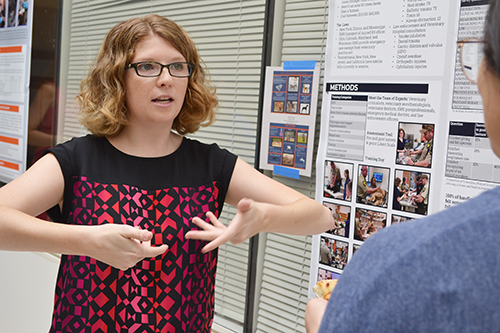
Danielle Schneider explains her research about training policement to do emergency treatments on their K9 companions.
Her dream job is, of course, working with working dogs. “I would kind of love to make working dogs a specialty of their own. There are such intricacies with working with them that people don't think about that. I think it's a whole field of veterinary medicine to go into, so it's something I might keep looking into.”
Her biggest challenge this summer was learning the writing process. “So it's very hard to write this awesome paper to submit,” she says. Luckily, she had lots of resources from the program about writing, plus, her mentor was very supportive.
“I've never written a research paper before, so that was very interesting,” she continues. “And I had a great mentor that just said, ‘Take a shot at it, and then we'll sit down and go over it together,’ which was great to do that on your own and then get feedback afterwards.”
How’d her paper turn out? They’re actually going to be submitting her paper to JAVMA (Journal of the American Veterinary Medical Association), which she calls, “Very exciting!” Even more exciting? She’s first author, “Which is great!” she admits.
Along with publishing a paper, she also gained skills using PubMed and doing poster sessions. “I never thought I would need a lecture on how to use PubMed for researching old papers,” she admits, “but when the librarian came in and gave that to us, I was like, ‘Whoa, there's so many things I didn't know about using PubMed!’ So now I'm really good at that.” Plus, they also got lectures on how to do poster presentations. “I've never done a poster before, so that was a learning experience,” she adds.
Her big takeaway from this summer, however, was: “That you can combine your passions,” she indicates. “I want to be a veterinarian, but I want to give back to working dogs still, and I learned that I can do that in this profession and make a difference.”
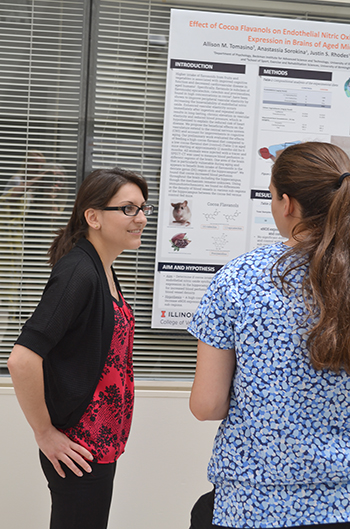
Vet Med student, Allison Tomasino (right), with STRP director, Lois Hoyer.
Allison Tomasino
Allison Tomasino, a rising second year vet med student partnered with Justin Rhodes from the Department of Psychology, conducted a study looking at the effect of cocoa flavanols on endothelial nitric oxide synthase expression in the brains of aged mice.
Regarding any challenges she encountered this summer, Tomasino said that—as with any research—there were challenges with the study in general. They had a little bit of frustration within immunohistochemistry, plus some of their samples were staining while others were not. “But that's science!” she admits.
In fact, she and her mentor would laugh because during the bi-weekly reports, Tomasino kept telling her, “We've got to redo this; we've got to redo this. This didn't work." Her PI said she reminded her of somebody from her past: “This person ended up putting on a bench top, 'The art of repetition!' because that's basically what my summer was.”
“But even though it was a bit frustrating at times,” Tomasino adds, “I'm happy with what we got, and we definitely found something interesting that can be used later. So it doesn't matter if you have negative results sometimes. What happened is the most important.”
When it comes to research, Tomasino has a stellar resume thus far given her young career. For example, in addition to this summer's research experience, she's also worked at the NIH (National Institutes of Health) and the Naval Medical Research Center.
She started off as a caretaker technician, not directly involved in research, but maintaining the rooms. After spending a year or so watching everyone else doing research, she said to herself, "I really want to be the one that is doing the experiments and making a difference!"
So Tomasino got a research assistant position working under orthopedic surgeons at the Naval Medical Research Center located within WRAIR (Walter Reed Army Institute of Research) in Silver Spring, where she worked her way up in that structure to the point where she was running research teams. Her work there was with animals, mainly rats, pigs, and nonhuman primates. “They were all animal studies,” she explains, “so they were the first steps in the research process because you start with animals and then go a little bit further, and then to humans after.”
“It was probably one of the best experiences I've ever had,” she asserts. There for three years, she had a hand in a lot of orthopedic surgery research. In fact, “One of my research projects is in clinical trials right now,” she reports, “which is pretty amazing. It was an amputation study. We developed a new prosthetic for the military, and it was amazing. Just knowing that even though you're a small part of research, just knowing it could get somewhere and make an impact is just such a great feeling, and I love it.”
Tomasino’s career goal is to work in a research facility setting with lab animals. “That has always been my passion ever since undergrad,” she reports. “Any way that we can improve animal and human health has just been a life goal for me. Obviously research kind of triggers that, so I did this program specifically to keep my research spirit alive.”
Her dream job is to be a lab animal veterinarian. So after her four years here at Illinois, she’s going to try to get a lab animal residency. She has a few programs in mind right now that are definitely the right steps to getting a residency in that field.
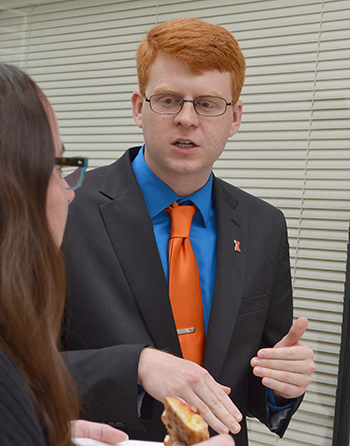
Vet Med student Bennett Lamczyk (right) discusses his research with a visitor during the poster session.
“I thought maybe after one year, there's so many different aspects of veterinary medicine, maybe I'll get a different mindset and do something else. But no, this is definitely where I want to be. I like research. I like pathology.”
Story and photographs by: Elizabeth Innes, Communications Specialist, I-STEM Education Initiative
For more related stories, see: Funded, Summer Research, Vet Med, 2018
For additional I-STEM articles about Veterinary Medicine, see:
- Vet Med Students Gain Knowledge, Skills During Summer Research Training Program
- 2015 Vet Med Open House Offers Visitors Hands-On Learning Opportunities
- Vet Med Open House Appeals to Young and Old Alike
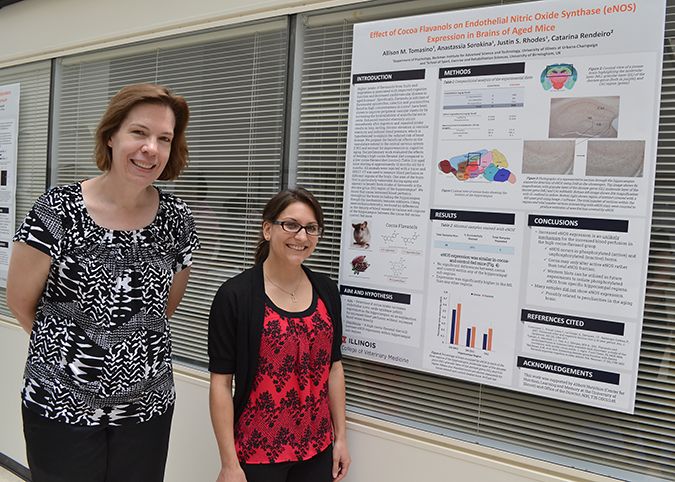
Left to right: STRP director, Lois Hoyer with Vet Med student, Allison Tomasino.













.jpg)
















